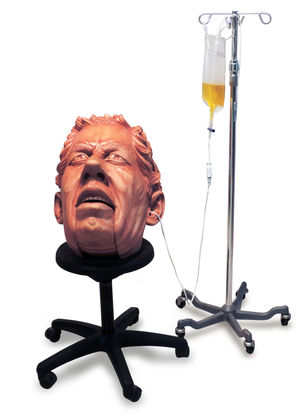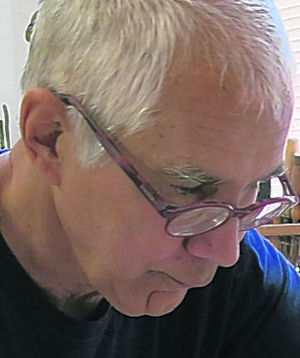By Joan Tupponce

But that sense of uncertainty doesn’t bother the self-taught sculptor. He’s just happy that his art starts a conversation.
He recalls a sculpture he started before 9/11 of a man in shirtsleeves sinking into the floor with outstretched arms. To people who viewed the sculpture after 9/11 it looked as if the figure was reacting to that tragic event, but the audience interpretation changed after the financial crisis that shook Wall Street.
“It looked like he was reacting to the financial crisis then. It looked like the bottom had fallen out financially, but that was not my intention,” Trotman said in an interview from his home in rural North Carolina.
Since starting his career, Trotman has received two grants from the National Endowment for the Arts and four from the North Carolina Arts Council. His work can be seen in the permanent collections of several museums, including the Virginia Museum of Fine Arts, the North Carolina Museum of Art and the Museum of Art and Design in New York.
His “Business as Usual” exhibit will run from Sept. 5 through Oct. 31 at the Visual Arts Center of Richmond. The center exhibited Trotman’s “Model Citizens” show in 2002.
“We made plans in early 2011 for this exhibition,” said curator Caroline Wright. “Bob has spent the last three years developing a new direction in his work.”

“We also have some of his studio experiments in fiberglass, concrete and wood,” Wright said.
An alumnus of Washington and Lee University with a degree in philosophy, Trotman moved to the small southwestern hamlet of Casar, N.C., in 1974 to adopt a “back-to-Earth” lifestyle.
“I wanted to become a craftsman and be my own boss,” he said.
For the next 23 years, he crafted furniture. But it wasn’t traditional by any definition. Most of the furniture had characteristics of a human figure. A chest of drawers, for example, was made in the figure of a man in a classic business suit. A table resembled a human figure bent over backward.
“The furniture depicted people you could empathize with but because it was a piece of furniture it could be used,” Trotman said. “It had a little political edge, but it was still furniture.”
Those furniture designs were the genesis of Trotman’s current sculptures.
“Because I had a lot of the human figure in the furniture, I was making sculptures all along, and finally the sculpture won out,” he said.
Trotman’s sculptures vary in size, from 30 inches tall to more than 7 feet.
“Varying the scale is like turning the volume up and down,” he said. “You change the viewers’ power relation by changing the scale.”
His goal is to create art that suggests “an absurdist officelike arena” that emphasizes corporate power and privilege.
“My point of view is sympathetic, but critical of the people I am depicting,” he said, noting that he draws inspiration from his childhood when his father was a banker in Winston-Salem. “There was a social hierarchy. That’s a lot of the background energy that I am tapping into. If there was such a thing as corporate purgatory, this is what it might look like.”
The Visual Arts exhibit includes kinetic sculptures with sound and motion, something Trotman started adding in 2010.
“I felt like it was an extension of the figures that reminded me of a circus or sideshow,” he said. “It extended the theatricality. I have things that light up or turn around. I wanted changes to happen in front of viewers’ eyes.”
One sculpture in the exhibit, “Slow Drip,” features a larger-than-life man’s head with an intravenous drip running into his ear. The man’s mouth is constantly opening and closing. The stool the head is perched on rotates randomly, giving off a sound that resembles a computer printer. Trotman creates the illusion that the man is talking to the room.
“He could be someone in the media, someone that is spreading fear,” Trotman said.
“My intent is not so much to make a statement but to put threads of meaning out there and then tie them in a knot. The head is in a corporate context because of the stool. The man is red; he’s angry, ranting about something.”
The IV drip that flows into his ear contains an unnamed yellow liquid.
“What is the liquid? That is up to the viewer,” Trotman said. “That is where I am leaving it. Different people see it different ways.”
Wright thinks this show represents an exciting period in Trotman’s career.
“‘Business as Usual,’ which is an ongoing series, is reflective of contemporary society but also of our culture over a long period of time,” she said. “Bob is creating work that is in some ways difficult and asks questions of the viewer. It offers interpretations for a wide variety of perspectives. I think that is what makes it interesting.”
In addition to the Visual Arts Center, Trotman’s art will be on display from Sept. 13 to Jan. 19 in the “State of the Art” exhibit at Crystal Bridges Museum of American Art in Bentonville, Ark. Alice Walton, daughter of Sam Walton, the founder of Wal-Mart, started the museum. Trotman is one of the 102 artists in the U.S. chosen from a field of more than 1,000 for the exhibit.
“It was a long process,” he said of the selection of artists. “I was happy and pleased. I feel lucky.”
Even though his art in both exhibits reflects some of his liberal ideas, Trotman hopes it doesn’t come across as preachy.
“I don’t know if I always succeed,” he said, adding, “I am also in the group that I am criticizing sympathetically.”
